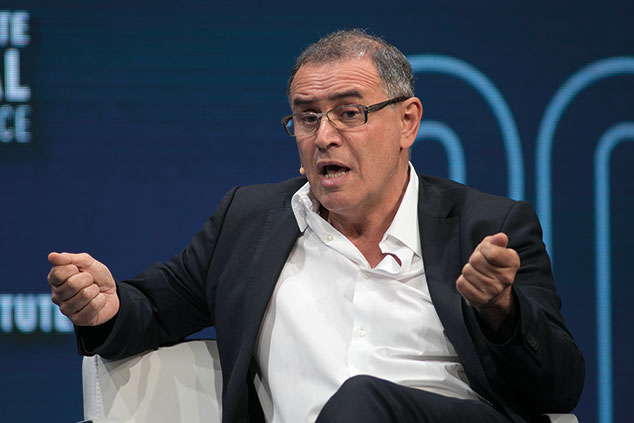
What is the blockchain?
It is an electronic database, or “distributed ledger”, of recorded transactions in which new deals are added to the chain and then stamped and protected by means of a complex mathematical equation so that the record can’t ever be changed.
The “distributed” bit means the record of transactions is consensually shared and synchronised across multiple “nodes” (hundreds or thousands of other computers in different companies, institutions, countries) making it (in theory) impossible for any single one of them to tamper with it. These nodes then use their computing power to compete to verify and decode the latest transaction, which is then added as the latest “block” in the “chain”.
What’s the idea behind it?
The idea is that the blockchain creates a universally verifiable, immutable and public record of all the transactions in the chain. Blockchain is, in effect, a high-tech attempt to answer the question: how can we create enough trust between transacting parties peacefully to exchange things of value? Traditionally, trust has been created via intermediaries such as banks, brokers and, ultimately, governments (and armies). In the case of a distributed (or “decentralised”) ledger system, the idea is that the need for a central authority is eliminated, since the system is self-reinforcing and self-policing. Moreover, since the records are kept communally in multiple sites, a distributed ledger is much harder to hack into.
How is it related to bitcoin?
Blockchain is the technology that bitcoin (and subsequent cryptocurrencies) is built on, and the word blockchain originated with bitcoin developers (although the design concept already existed). The name “blockchain” was coined because the bitcoin mining transactions coming onto the network were grouped into “blocks” of data, and then verified and “chained” together by means of a sophisticated mathematical (or “cryptographic”) puzzle. This verification element (by means of what is known as a “consensus algorithm”) is a vital part of the system. In the case of bitcoin, different nodes compete to “mine” the correct answer to the puzzle, employing intensive computing power and getting some currency as a reward.
Hasn’t bitcoin crashed and burned?
It depends on your time frame. Compared with a peak of over $17,000 at the height of investors’ exuberance in December 2017, this week’s level of around $3,400 looks grim. Compared with the original sub-$10 price, it looks remarkable. But at the very least, in the first ten years of its life it has demonstrated remarkable, cockroach-like resilience, argues US legal academic Kevin Werbach, author of The Blockchain and the New Architecture of Trust. Sure, it hasn’t become the widespread payment mechanism its early boosters envisioned. But it has (so far) survived all kinds of troubles, including technical problems, developers’ personality clashes, business disputes and price bubbles/collapses.
“I expect bitcoin will represent a smaller share of cryptocurrency value in ten years’ time, but it won’t be zero,” says Werbach. In the meantime, the underlying blockchain technology has enormous potential.
Such as?
The advertising industry, for example, is working on ways of using blockchain to track advertisements over the internet; the music industry to track songs. Banks and mortgage firms (and even national land registries) hope to use it to track deeds. Shipping and pharmaceutical firms are examining how to use blockchain to track goods and verify and streamline supply chains. And the financial industry has big hopes for the technology, spending an estimated $1.7bn to date. JPMorgan Chase’s Jamie Dimon has dismissed bitcoin as a vehicle for hucksters, but says “the blockchain is real”. His bank is the leading player in the Interbank Information Network, which is applying the technology to cross-border currency transfers. Many analysts think blockchain could transform the administration-intensive fund-management industry. It “has the potential to wipe Luxembourg off the map of the fund distribution and administration market”, reckons a Deloitte report.
Who else is investing?
IBM has a whole new division focused on blockchain, as do Accenture and PwC. Energy firms including Royal Dutch Shell, Mercuria and Gunvor, together with finance groups including ING, Societe Generale, Citigroup and ABN Amro, are among the backers of two new blockchain platforms, called Komgo and VAKT, focused on trade financing. The idea is to digitise contracts, letters of credit, invoices and other paperwork whizzing round the world by email, fax and post – and transfer everything on to the Ethereum blockchain platform instead – and that that will lead to big wins in terms of cost and speed.
Who is sceptical?
The voices of sceptics have grown louder as real-world applications remain in the early stages and/or have not lived up to the hype. Nouriel Roubini, the “Dr Doom” professor famed for predicting the 2008 crisis, reckons the versions of blockchain being developed by responsible firms and governments are not really blockchain, since they require permissioned access and centralised authorities to oversee them. Blockchain itself he derides as “nothing more than a glorified spreadsheet” and “the most overhyped – and least useful – technology in human history”. His detractors in computing science suggest he doesn’t actually understand the technology. The truth, of course, is that the blockchain revolution (if, in fact, it exists) remains in its infancy. Along the way there will be huge failures, massive wasted investments and no shortage of scams, argues Andrew Ross Sorkin in The New York Times. But a decade from now “it’s more likely than not that blockchain will be embedded in our day-to-day lives in ways that, today, we can’t even imagine”.